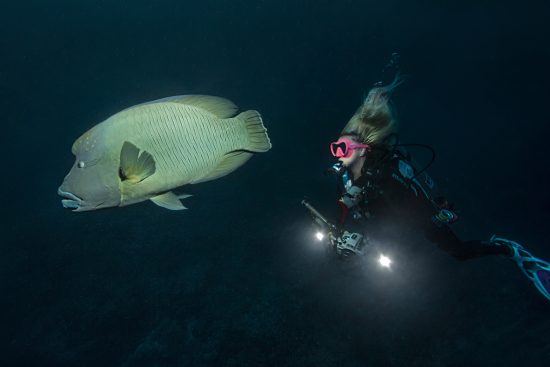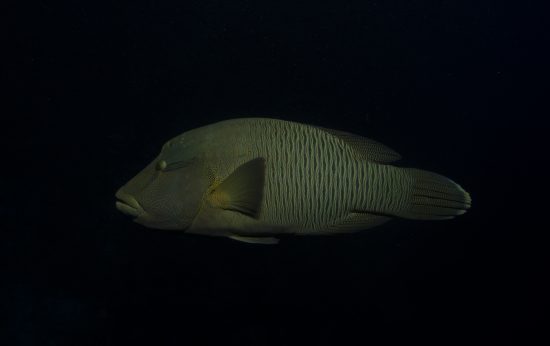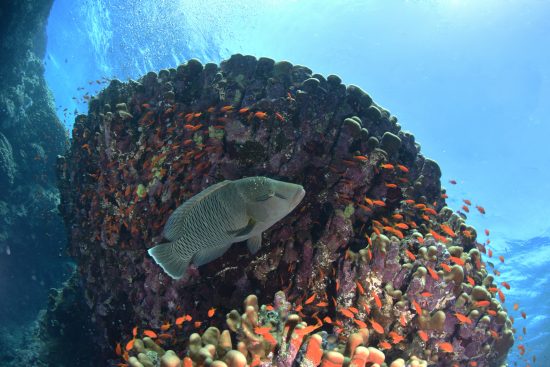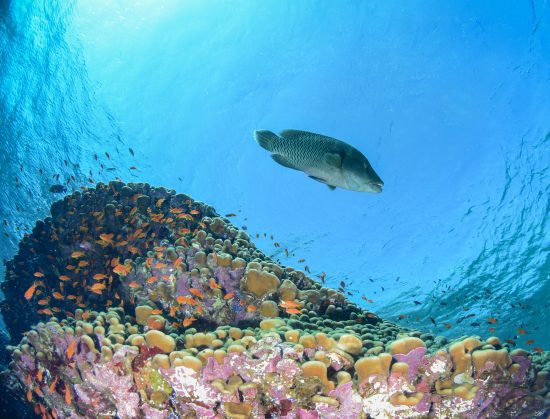






The Napoleon fish is a humphead species of wrasse living in the Indo-Pacific and Red Sea coral reefs, also called 'Maori wrasse' or 'Napolean wrasse'. Out of over 600 species in the wrasse Labridae family, this one is easily recognisable due to its large size, a very distinct hump on their heads and large thick lips. The hump gets bigger with age and is thought to be an attractive feature to females who take the size of the hump as a sign of genetic health. Their eyes are inset with very characteristic black lines around them which make them look like they have eyelashes. This is the largest species of wrasse, with males growing much larger than females. They can even reach 2m in length and 180kg in weight. They are blue-grey, green in colour mostly, but some can be very colourful, almost purple. You cannot mistake them for any other fish!
They live alone, sometimes in pairs or small groups, and like many other wrasse species they are territorial. They form pairs but spawn in groups and release eggs and sperm into the water column at the same time. They are protogynous hermaphrodites - all are born female or ‘initial phase’ male, and when they reach sexual maturity between 5 and 7 years of age, the ‘initial’ males turn into ‘terminal’ males. If there is a shortage of males, the females turn into males around nine years old. Unlike other wrasse species, humphead wrasse cannot turn back to being female after becoming male. It is a very long-living species (30 years on average) of wrasse with a slow breeding rate. As they have high larval mortality combined with a slow breeding cycle and overfishing, Napoleon fish are endangered, and their population is decreasing. The larvae are pelagic, which means that anything bigger than them eats them.
They feed on crustaceans, starfish and molluscs. They are quite high in the food chain, top predators of the reefs, and a very important species which keeps the populations of their food choice in check. Their favourite food is the crown-of-thorns starfish which can destroy the reef if not controlled.
A fish that large has very few predators, but over the years they have become the subject of overfishing as they are a valued luxury food in Southeast Asia, especially in Hong Kong. As the price for them has gone up, so has the demand for them, but some nations recognise the important role that Napoleon fish play in a healthy reef. There is a buy-back programme organised by the WWF in Malaysia and almost 1,000 humphead wrasse have been released back into the wild since its formation. They tend to only be found on protected reefs such as coral reefs in the Maldives.
For now, they are considered rare, so consider yourself very lucky if you come across this majestic species during your diving adventures!
For diving with Napoleon fish, contact: https://www.seven-seas-online.de/en/
Written by Bogna Griffin, Freshwater and Marine Biologist
Photos by Jonas Heeb and Ivana OK
 Ivana and Janez
Ivana and Janez 16th August 2021
16th August 2021